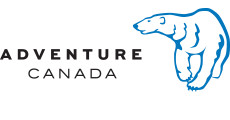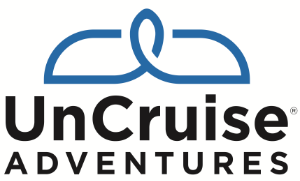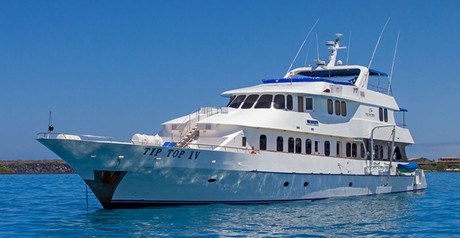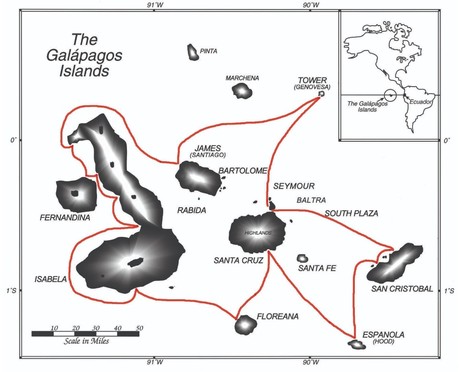Galapagos 14 Day Expedition
This is our most popular itinerary, especially from North America where vacations are shorter; it spends 11 days aboard the yacht, but can fit into a two week vacation. This program has a very strong Natural History focus and is appropriate for most photographers, You visit the significant outer islands, and its pace allows for a maximum of wildlife observation.
Highlights
• TOWER & NORTH SEYMOUR
• SANTIAGO & ISABELA
• FERNANDINA & FLOREANA
• ESPANOLA & MOSQUERA
On arrival at Quito's airport (typically in the evening), you will be met and transferred directly to the centrally located HOTEL MERCURE ALAMEDA where we will spend the night.
Today is a free day in Quito, with a wide range of half-day, full-day and multi-day expeditions – see EXPLORE ECUADOR, for options. Lunch and dinner on your own. Overnight Quito.
A very early morning flight will take you from the High Andes, to another world; the Galapagos Islands. Upon landing on Baltra Island we will be will be transferred to the yacht, which will be waiting for the group in the nearby harbor. This afternoon you will begin your island explorations. On arrival in Galapagos we will immediately transfer to the yacht waiting at the nearby harbor. This afternoon we will begin our program of shore excursions with a visit to the island of NORTH SEYMOUR. In addition to being a major nesting area for the blue-footed booby, North Seymour is home to the largest colony of magnificent frigatebirds in the Galápagos. Both marine and land iguanas are found in good numbers here, and sea lions often surf the rocky shore break.
TOWER – Located in the northeast portion of the Galápagos, Tower is an outpost for many sea birds (as is Española to the south - perhaps this is why they are our two favorite islands). Depending on conditions we often will have a chance to snorkel and kayak within the bay. • Darwin Bay is an anchorage within a caldera, with surrounding cliffs forming the inner portion of the rim. Along the small beach there is a forest of salt bush where adjacent colonies of great frigatebirds and red-footed boobies nest. There are two endemic gull species found in Galápagos; lava gulls and swallow-tailed gulls – both frequently nest here. Tidepools are a favorite haunt of herons. • A visit to Prince Philip’s Steps begins with a panga ride along the cliffs, watching for red-billed tropicbirds and the occasional fur seal, while squadrons of frigatebirds fly overhead in their endless piratical pursuits. On shore dwarf palo santo trees are home to a colony of red-footed boobies, while Nazca Boobies nest below on the ground. Along the lava fields storm petrels fly overhead in great numbers, while short-eared owls hunt for them among the lava cracks.
SANTIAGO – James Bay/Puerto Egas is home to Fur Seal Grotto - not only a beautiful site, but this is your only chance to get close to the endemic fur seals. Some of the best tide-pooling is also here, drawing a wonderful variety of shorebirds and seabirds, with yellow-crowned night herons and American Oystercatchers being the most commonly seen. Inland you might have a chance to see painted locusts, grasshoppers, and possibly even the Galápagos snake. Galápagos flycatchers and Galápagos hawks are also common on the inland trail. The snorkeling here is in shallower water, getting you closer to the smaller sea life. • Playa Espumilla is a golden sandy beach where sea turtles nest, and ghost crabs and wading birds abound. Beyond the mangroves that frame the beach lie saline lagoons; further in you can find some of the 10 finches that inhabit Santiago, along with the vermillion and broad-billed flycatchers. • Following our hike we will explore Buccaneer Cove from the yacht. This is one of the places where Charles Darwin went ashore - a site historically used by sailers to cleans ships, hunt meat, and collect firewood and water. Impressive tuff cliffs frame the southern cove, while eroded cinder to the north has been carved by time into fanciful shapes.
ISABELA – The cold waters approaching Punta Vicente Roca offer some of the best opportunities for whales and dolphins. Zodiac cruise and snorkel here and you may be rewarded with mola mola, penguins and turtles. • FERNANDINA - This is the youngest of the Galápagos Islands. Punta Espinosa is a wonderful visitor site, with the largest colony of marine iguanas in the islands, in addition to flightless cormorants, Galápagos Penguins, herons and Galápagos Hawks. For endemic flora the island is home to some of the best stands of Lava Cactus. This is often the best place to see marine iguanas in the water as they feed on the barely submerged rocks along the shore.
ISABELA – Tagus Cove is a natural harbor featuring steep cliffs replete with graffiti from ship’s crews dating as far back as 1836 carved into the face. The cliffs are populated by marine iguanas, penguins, crabs, sea lions, and in the crevices outside the bay, brown noddy terns and the occasional Galápagos Martin. Ground and tree finches, hawks, yellow warblers, large-billed flycatchers and perhaps the woodpecker finch can be viewed along the way. • Elizabeth Bay is a mangrove inlet explored by zodiac, with an amazing concentration of green sea turtles and rays. The neighboring Marielas Islets are home to the largest colony of Galápagos Penguins, with penguins often seen in the water at Elizabeth Bay.
ISABELA - Urvina Bay was the site of a dramatic volcanic uplift in 1954, where 4 miles of coastline suddenly rose nearly 15 feet, with the coastline driven three quarters of a mile farther out to sea. The marine remnants and giant coral heads are a stark reminder. Inland land iguanas, and an occasional tortoise, are often found here. Along the shore flightless cormorants and brown pelicans typically nest. We might have a chance to snorkel along the rocky bay. • Situated against a backdrop of 3 volcanos, Punta Moreno features views of Isabela’s Sierra Negra & Cerro Azul, and Fernandina’s Le Cumbre. The trail traverses sharp Pahoehoe lava to verdant interior and coastal brackish lagoons. You’ll find all 3 types of cactus colonizing this relatively recent lava flow. The shoreline features Blue-footed Boobies and nesting flightless cormorants while the lagoons are home to white-cheeked pintail ducks and flamingos feeding on abundant brine shrimp.
FLOREANA – Punta Cormorant is one of the most interesting landings in Galápagos, on an olivine beach, with an emphasis on unique plant life and shore birds. A large brackish lagoon is home to flamingos, pintail ducks, and commons stilts. Flour Sand Beach here is a favorite nesting beach for the Green Sea Turtle. Offshore Champion Islet offers great snorkeling as well as a chance to spot the endemic Charles Mockingbird from the zodiacs. • Post Office Bay is one of the most historically famous sites - be sure to bring a postcard or two ashore with you to "mail" from the barrel that has been in use by passing sailors for decades. • Black Beach & the Highlands are outside the national park lands, yet quite rewarding. Much of the early human history of the Galápagos, and especially the Wittmer family, played out in the highlands of Floreana. A visit to the highlands is also your only opportunity in the archipelago to search for the endemic medium tree finch. The village here is home to about 60 people, with the seaside Wittmer hotel featuring an exhibit of early photographs from sailing expeditions and explorers to call on the island.
SANTA CRUZ - A trip to the Highlands (by mini-bus) traverses all 7 vegetation zones of the Galápagos. In addition to two enormous pit craters, other volcanic formations include some of the largest known lava tunnels in the Galápagos. Not surprisingly, the lush highland vegetation is home to a variety of land birds, including vermillion flycatchers, Galápagos Flycatchers, woodpecker finches, dark-billed cuckoos, and Barn Owls. Tortoises are often seen in the wild here. • Puerto Ayora is the scientific heart of Galápagos, including the Charles Darwin Research Station (CDRS) and Galápagos National Park tortiose center, as well as the primary population center. This will be the only opportunity to see the rare Galapagos saddleback tortoises.
ESPANOLA - Punta Suarez is a paradise for birders, with waved albatross, Nazca Boobies, blue-footed boobies, Galápagos Hawks, Galápagos Doves, and also marine iguanas (the most colorful in the islands) all vying for center stage. • Gardner Bay is a tranquil white sandy beach known for sea lions (often numbering in the hundreds), lava lizards, finches, yellow warblers, & Hood Mockingbirds, to name just a few. • Gardner or Tortuga Rocks offer great snorkeling, as well as the occasional chance to kayak.
SAN CRISTOBAL - This is the easternmost island in the archipelago (and also the provincial capital). • Punta Pitt is a coastal tuff formation that serves as a nesting site for many sea birds, including blue-footed, Nazca & red-footed boobies (the only site where all 3 species might be seen together), frigatebirds, swallow-tailed gulls, and storm petrels. • Cerro Brujo is a very striking, eroded tuff cone. One of the first places visited by Charles Darwin, the beautiful white coralline sand beach and lagoon are home to brown pelicans, blue-footed boobies and swallow-tailed gulls, plus a variety of shore birds. Stroll the beach and you will soon realize that you are being watched by hundreds of shy ghost crabs. San Cristóbal is also home to the endemic Chatham Mockingbird. • Kicker Rock is a similarly eroded tuff cone, this time rising almost 500 feet from the ocean. The yacht will cruise around Kicker Rock as the sunlight plays off the contours of the cliffs and formation (complete with blue-footed boobies, Nazca Boobies, and frigatebirds).
(morning): MOSQUERA - This is a tiny islet, really more of a long, narrow sand spit, with a huge population of sea lions. Additional occupants include Sally Lightfoot Crabs and lava lizards, plus a wonderful variety of birdlife flying over. It makes a perfect "last landing" to reflect on the wonders of Galápagos experienced during your 11 days in the islands. • BALTRA - A mid-morning departure will have us back in Quito this afternoon. (afternoon): On arrival back in Quito we will be transferred to the HOTEL MERCURE ALAMEDA where we will spend the night. We will have a group Farewell Dinner in Quito this evening.
Transfer to the airport today for your return flight home. Or, remain in Ecuador exploring the High Andes, Amazon Basin, or tropical cloud forests. See Explore Ecuador for options.
Itineraries are subject to change.
Vessel Type: Motor Yacht
Length: 27 metres
Passenger Capacity: 16
Built / refurbished: 2006 / 2015
The 125 ft, steel-hulled, TIP TOP IV was built in Guayaquil, Ecuador in 2006, and totally refurbished in 2015. The design includes all modern navigation instrumentation and safety features. She has a crew of 7 and carries just 16 passengers in 10 air-conditioned double cabins (4 on the bridge deck and 6 on the lower deck). All cabins feature 2 lower twin beds, which can also be modified to create a double bed if guests prefer. The interior is very spacious and attractive, and features a library/conference room, and a spacious dining room. There are extensive outside viewing (both sun and shade) areas. Twin diesels give her a cruising speed of 12 knots. Shore landings are made via twin 17-foot inflatable zodiacs. Special equipment on board includes basic snorkeling gear to loan as well as kayaks.


Inclusions
• All accommodations, including 3 nights in a First Class hotel in Quito, Ecuador and 10 or 14 nights aboard the yacht in the Galápagos. Accommodations in Quito include 2 people sharing a double room. If you prefer your own room, there is a Single Supplement Cost (please contact us for more information). All boat cabins must be shared, except by special arrangement (a single accommodation option is available at an additional cost - space is limited)
• All meals and non-alcoholic beverages aboard the yacht, and most meals (as indicated in the itinerary) in Quito.
• All airport transfers in Quito and the Galápagos.
• The services of an expert-level Tour Leader accompanying the group and a University-level Naturalist Guide conducting the land tours.
• Governmental yacht Fuel Tax.
Exclusions
• Any airfare (the Quito/Galápagos roundtrip is currently $560 per person)
• Galápagos National Park Entrance Fee (currently $100 per person)
• Galápagos Tourist/Migration Card (currently $20 per person)
• Gratuities to guide and crew (suggested at roughly $20-$25 per day but discretionary)
• Alcoholic beverages.
• Trip Cancellation Insurance Coverage is strongly suggested, both to protect your investment in the tour, and also to safeguard yourself in the case of an accident while abroad - you will be traveling to a remote and wonderful corner of the globe that however has minimal ready care in the case of a medical emergency.
Our Associates Include







